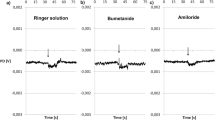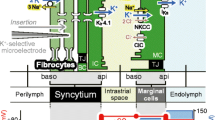Summary
The potential profile of the frog skin epithelium incubated in Cl-Ringer was reinvestigated with improved technique. Under open circuit conditions (PDtr up to 120 mV) the potential profile was demonstrated to be trough like in contrast to the stair-step like potential profile reported by previous investigators which has probably been recorded after injuring of the punctured cells.
In 67 successful impalements the potential difference across the basolateral membranes was 108±2 mV. The potential across the outer, epithelial-facing membrane was inversely related to the transepithelial PD, but was found to be negative (with respect to the epithelial bathing solution) in all punctures. Electrogenic sodium transport might be responsible for part of the potential difference across the basolateral membranes which correlated directly with the short circuit current. The intracellular potential in the short circuited state was −73±2 mV and decreased with increasing short circuit current. It is suggested that these changes result from variations of the outer membrane sodium conductance.
Similar content being viewed by others
References
Biber, T. U. L., Chez, R. A., Curran, P. F.: Na transport across frog skin at low external Na concentrations J. gen. Physiol.49, 1161 (1966)
Biber, T. U. L., Curran, P. F.: Direct measurement of uptake of sodium at the outer surface of the frog skin. J. gen. Physiol.56, 83 (1970)
Caldwell, P. C.: Liquid junction potentials and their effect on potential measurements in biological systems. Int. Rev. Cytol.24, 345 (1968)
Cereijido, M., Curran, P. F.: Intracellular electrical potentials in frog skin. J. gen. Physiol.48, 543 (1965)
Cereijido, M., Rotunno, C. A.: Fluxes and distribution of sodium in frog skin. A new model. J. gen. Physiol.51, 280s (1968)
Davis, T. L., Jackson, J. W., Day, B. E., Shoemaker, R. L., Rehm, W. S.: Potentials in frog cornea and microelectrode artifact. Amer. J. Physiol.219, 178 (1970)
Engbaek, L., Hoshiko, T.: Electrical potential gradients through frog skin. Acta physiol. scand.39, 348 (1957)
Helman, S. J., Fisher, R. S.: Localization and determination of the driving force for sodium transport by the frog skin. Fed. Proc.35, 702 (1976)
Higgins, J. T., Frömter, E.: Potential profile in necturus urinary Bladder. Pflügers Arch.347, R 32 (1974)
Higgins J. T., Jr., Cesaro, L., Gebler, B., Frömter, E.: Electrical properties of amphibian urinary bladder epithelia. I. Inverse relationship between potential difference and restance in tightly mounted preparations. Pflügers Arch.358, 41 (1975)
Hvid-Larsen, E.: Effect of amiloride, cyanide and ouabain on the active transport pathway in toad skin. Alfred Benzon symposium: Transport mechanism in epithelia, p. 132. Copenhagen: Munksgaard 1973
Koefoed-Johnsen, V., Ussing, H. H.: The nature of the frog skin potential. Acta physiol. scand.42, 298 (1958)
Nagel, W.: Reinvestigation of intracellular PD of frog skin epithelium. Abstr. 5. Intern. Biophys. Congr. Copenhagen (1975)
Nunes, M. A., Lacaz Vieira, F.: Negative potential level in the outer layer of the toad skin. J. membrane Biol.24, 161 (1975)
Rawlins, F., Maten, L., Fragachan, F., Wittenbury, G.: Isolated toad skin epithelium: Transport characteristics. Pflügers Arch.316, 64 (1970)
Tasaki, I., Polley, E. H., Orrego, F.: Action potentials from individual elements in cat geniculate and striate cortex. J. Neurophysiol.17, 454 (1954)
Thomas, R. C.: Electrogenic sodium pump in nerve and muscle cells. Physiol. Rev.52, 563 (1972)
Ussing, H. H., Windhager, E. E.: Nature of shunt path and active sodium transport path through frog skin epithelium. Acta physiol. scand.61, 484 (1964)
Voute, C. L., Hänni, S.: Relation between structure and function in frog skin. Alfred Benzon Symposium: Transport mechanism in epithelia, p. 86 Copenhagen: Munksgaard 1973
Voute, C. L., Ussing, H. H.:The morphological aspects of shuntpath in the epithelium of the frog skin (R. temporaria). Exp. Cell Res.61, 133 (1970)
Whittembury, G.: Electrical potential profile of the toad skin epithelium. J. gen. Physiol.47, 795 (1964)
Author information
Authors and Affiliations
Additional information
Supported by the Deutsche Forschungsgemeinschaft
Rights and permissions
About this article
Cite this article
Nagel, W. The intracellular electrical potential profile of the frog skin epithelium. Pflugers Arch. 365, 135–143 (1976). https://doi.org/10.1007/BF01067010
Received:
Issue Date:
DOI: https://doi.org/10.1007/BF01067010




